Intel X38 Tango - Is High FSB Overclocking Worth It?
by Rajinder Gill on February 26, 2008 3:30 AM EST- Posted in
- CPUs
Judges Scores for the E8500 Quickstep
Crysis
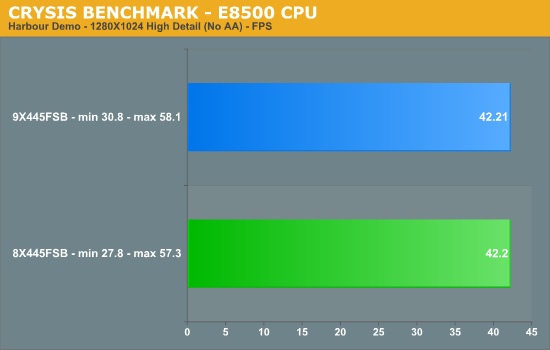
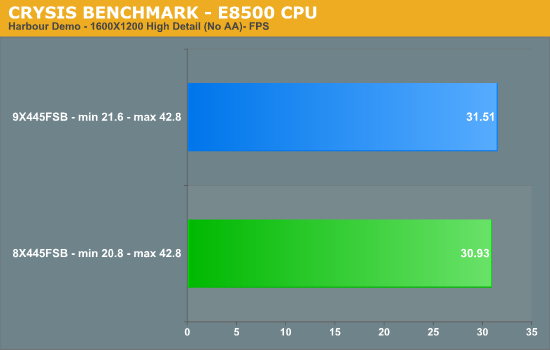
Unreal Tournament 3
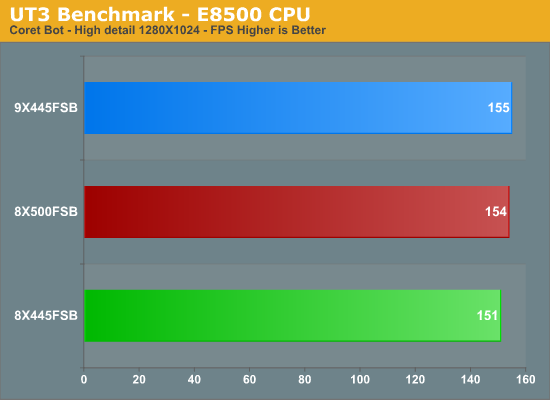
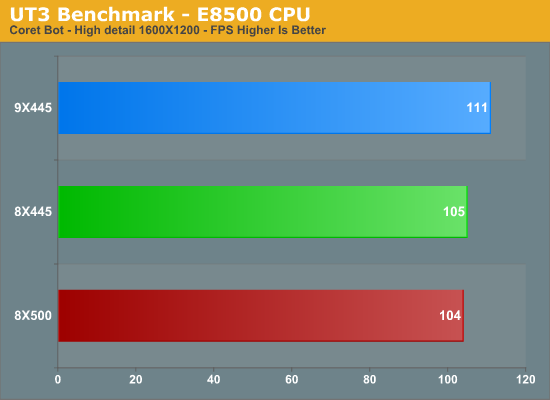
Cinebench 10
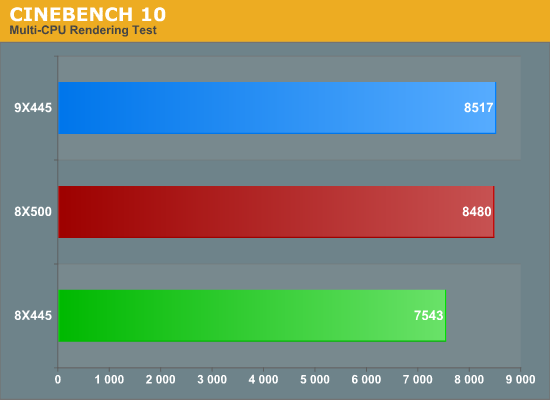
WinRAR 3.70
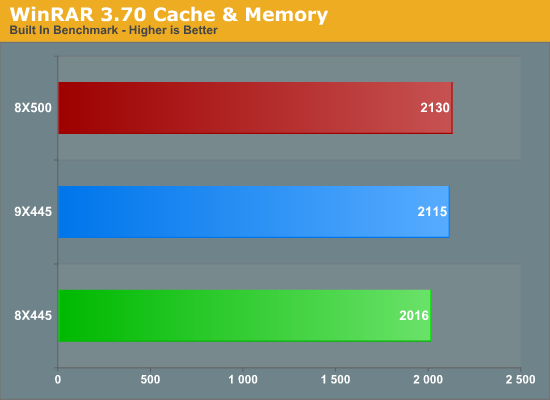
In the Crysis test, full stability is not achievable at 500FSB using the 8x multiplier, and we barely could finish benchmarks at the 7x multiplier. We tried a number of methods to get beyond this issue including Clock Twister adjustments, 2N memory speeds, and even an increase in CAS Latency and memory sub-timing adjustments. All of our endeavors failed; even with reduced performance levels we still had system instability.
This may be due to the rather coarse GTL adjustments offered by the Maximus Extreme, but more likely the problem is that Crysis is a very unforgiving benchmark at high FSB/Multiplier speeds. Therefore, a 45nm processor with anything less than an 8.5 multiplier is going to struggle in achieving 4GHz stable on this particular board when running this application.
We chose to run Crysis at high detail levels, as we believe owners of an 8800 GTS 512 will want to do the same. It is clear that a mere 100MHZ extra on the processor will do nothing for your frame rates at high detail levels, as the game is obviously GPU limited. We did notice a slight separation of 3~5 FPS between the multiplier settings on medium details.
In our other benchmarks, UT3 and CINEBENCH actually score better with the lower tRD of 6 at 445FSB in comparison to a tRD setting of 7 at 500FSB. However, WinRAR shows a different result with the 8x multiplier delivering better scores. Given that WinRAR depends a lot on memory bandwidth, that result is not too surprising. In additional application testing across several games and video/audio programs, we generally found the 9x multiplier scored better - sometimes in a measurable fashion - while always remaining stable.










15 Comments
View All Comments
AndyKH - Thursday, February 28, 2008 - link
When reading the article, I didn't find any info on how you adjusted tRD. I thought such adjustments weren't available in the BIOS except for certain X48 boards from ASUS (unless you resorted to FSB strap settings that might limit memory ratios). Is this setting beginning to show up on X38 boards as well?Rajinder Gill - Thursday, February 28, 2008 - link
There is a full BIOS guide for this board here (part of the full review).. 'Transaction Booster' is the function.http://www.anandtech.com/mb/showdoc.aspx?i=3172&am...">http://www.anandtech.com/mb/showdoc.aspx?i=3172&am...
regards
Raja
Aurhinius - Thursday, February 28, 2008 - link
I'd be interested to see something like this done with a Max formula board. Takes the X38 and pairs it with DDR2 rather than DDR3 which is still out of sensible reach for most people due to price.Then you can compare memory performance and settings on the same chipset with the two types of memory. Throw a quad in to the mix as well.
It's also going to illuminate any benefits (if there are any) of moving to an X48 platform from an X38.
Keep up the great work. These articles are a world apart from anything else I have seen and has people thinking how they evaluate their systems at all levels of experience.
Well done!
Rajinder Gill - Thursday, February 28, 2008 - link
A DDR2 version will be incoming, as well as X48 asap. We have a few reviews to get done first, but will try to incorporate this form of testing into them..regards
Raja
Zak - Wednesday, February 27, 2008 - link
Nicely written indeed but I gave up on overclocking, the real life benefits are not worth the effort. My 3GHz C2D runs at 3.6GHz easily with Tuniq Tower. Do I notice any difference in games? Photoshop? Nope. I used to get more excited about o/clocking I guess it passed with age:) Good luck to everyone though:)Z.
Nickel020 - Tuesday, February 26, 2008 - link
I quite like the recent articles, that kind of quality infos & analysis is very rare.I also liked the inclusion of some real world benchmarks, although the tRD article was great, I was missing some benchmarks demonstrating the real world effects.
Only thing is that DDR3 is still not an issue for most people, but the article is still well worth reading since since it explains underlying factors that affect performance.
menting - Tuesday, February 26, 2008 - link
the author questions why some memory manufacturers sell CAS9 DDR3-1900 as "performance memory" even though it means it has pitiful cas latency. The reason is that "performance" cannot be judged by cas latency alone. Sure with a low latency you can get a burst of data quicker, but with back to back reads on a memory, a higher clock speed is better. So it all depends how you want to look at it and how applications make use of the memory.Rajinder Gill - Tuesday, February 26, 2008 - link
Hi,I would still rather buy performance parts that scale to Cas 7 at ddr 1800 than Cas 9 at DDR 1900+. The FSB/tRD and VMCH requirements just don't make intelligent sense. Then we have the 2N command rate to play with when we begin to scale much past DR-1900. I would call it a lose-lose situation.
regards
Raja
Griswold - Tuesday, February 26, 2008 - link
Disco Stu likes the style of this article!Samus - Tuesday, February 26, 2008 - link
An unusually written article if I've ever seen one ;)